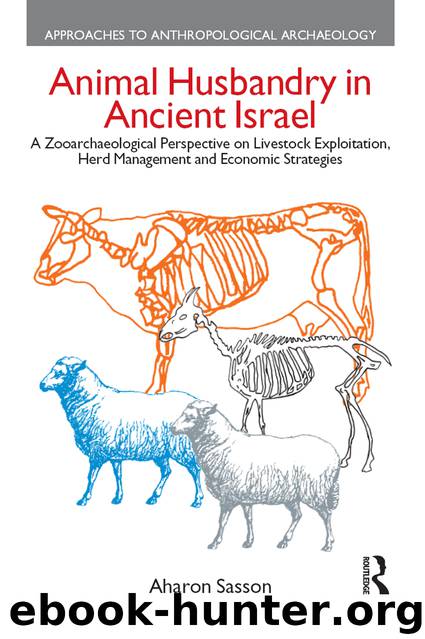Animal Husbandry in Ancient Israel by Sasson Aharon;

Author:Sasson, Aharon;
Language: eng
Format: epub
ISBN: 4500517
Publisher: Routledge
Table 3.4 Cattle mortality profile, based on epiphysial fusion.
Donkey. Four specimens of domestic donkey (Equus assinus) were discovered in Stratum II. They are originated in three loci and comprise 2 carpal bones and 2 lower molars (M/1 and M/2) generating an MNI value of 1. The molar teeth were identified as domestic donkey rather than horse based of criteria listed by Davis (1980). Donkey bones in the Iron Age II, were also found at Tel Hesban (LaBianca 1990), Pella (Kohler-Rollefson 1992a), Tel Lachish (Croft 2004), Tel Jemmeh (Wapnish and Hesse 1988), and the site of the City of David (Horwitz 1996b).
Dog. Seven specimens of dog (Canis familiaris) were identified. They originated in seven loci and include two humeri, femur, astragalus, metatarsal and two lumbar vertebrae, generating an MNI value of 1. Dog bones, in the Iron Age II, were also found at Tel Lachish (Croft 2004), Tel Dan (Wapnish and Hesse 1991) and Tel Masos (Tchernov and Drori 1983).
Pig. Nine specimens of pig (Sus scrofa) were identified. They originated in three loci and include two first phalanx bones, scapula, metatarsal and two fragments of mandibula, generating an MNI value of 1. The phalanx bones were found unfused indicating they originated in a two year old individual (Silver 1969). Pig bones, in the Iron Age II, were also found at Tel Hesban (LaBianca 1990), Pella (Kohler-Rollefson 1992a), Tel Lachish (Croft 2004), Tel Jemmeh (Wapnish and Hesse 1988), Tel Miqne (Lev-Tov 2000), Tel Dan (Wapnish and Hesse 1991) and Tel Qiri (Davis 1987b).
It is evident that pigs were not used for consumption at Stratum II. As discussed above, animals that were exploited for food, would leave a profound mark on the zooarchaeological record. There is an ongoing debate as to whether the taboo on pigs originated for practical-ecological reasons or cultural-ideological (cf. Harris 1974; Diener 1978; Hesse 1990; Zeder 1996; Raban-Gerstel, et al. 2008). It is possible that pigs were avoided in Iron Age Tel Beer-Sheba due to religious taboo. Nonetheless, I advocate the notion that the primary reason for the taboo on pigs, in many regions of the Southern Levant, was ecological. Pork would have made a considerable contribution to the human diet (Sasson 1998). However, caprines and cattle provided adequate animal-derived nutrients as well as wool, hair and hides (Sasson 2006). Bearing in mind that ancient populations strove to minimize risks in order to maintain a long-term survival, pig husbandry would have stood in contrast with this strategy. Pigs need to be watered daily and do not cope well with temperature extremes (Harris 1974:40–42; Van Loon 1978). Furthermore, a large part of the Southern Levantine population engaged in some mode of mobility, which made pig husbandry impractical. Gradually, the ecological practice evolved into a cultural-ideological belief.
Gazelle. Ten specimens of gazelle were identified. They originated in eight loci and include two first phalanx bones, a scapula, a metatarsal, a horncore and five vertebrae (thoracic and lumbar), generating an MNI value of one. The geographic context suggests that the specimens belong to the mountain gazelle (Gazella gazella).
Download
This site does not store any files on its server. We only index and link to content provided by other sites. Please contact the content providers to delete copyright contents if any and email us, we'll remove relevant links or contents immediately.
| Automotive | Engineering |
| Transportation |
Whiskies Galore by Ian Buxton(41529)
Introduction to Aircraft Design (Cambridge Aerospace Series) by John P. Fielding(32888)
Small Unmanned Fixed-wing Aircraft Design by Andrew J. Keane Andras Sobester James P. Scanlan & András Sóbester & James P. Scanlan(32573)
Craft Beer for the Homebrewer by Michael Agnew(17933)
Turbulence by E. J. Noyes(7700)
The Complete Stick Figure Physics Tutorials by Allen Sarah(7137)
Kaplan MCAT General Chemistry Review by Kaplan(6595)
The Thirst by Nesbo Jo(6435)
Bad Blood by John Carreyrou(6274)
Modelling of Convective Heat and Mass Transfer in Rotating Flows by Igor V. Shevchuk(6222)
Learning SQL by Alan Beaulieu(6035)
Weapons of Math Destruction by Cathy O'Neil(5829)
Man-made Catastrophes and Risk Information Concealment by Dmitry Chernov & Didier Sornette(5646)
Digital Minimalism by Cal Newport;(5389)
Life 3.0: Being Human in the Age of Artificial Intelligence by Tegmark Max(5184)
iGen by Jean M. Twenge(5161)
Secrets of Antigravity Propulsion: Tesla, UFOs, and Classified Aerospace Technology by Ph.D. Paul A. Laviolette(4990)
Design of Trajectory Optimization Approach for Space Maneuver Vehicle Skip Entry Problems by Runqi Chai & Al Savvaris & Antonios Tsourdos & Senchun Chai(4839)
Electronic Devices & Circuits by Jacob Millman & Christos C. Halkias(4748)
